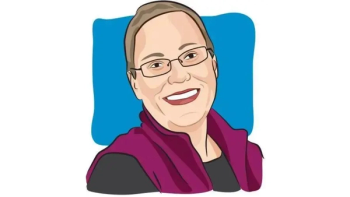
Surgical Intervention May Improve Survival in Young Patients with Breast Cancer
Key Takeaways
- Risk-reducing mastectomy and salpingo-oophorectomy improve survival outcomes in young BRCA mutation carriers with early-onset breast cancer.
- The study included 5,290 patients from 33 countries, with significant reductions in DFS, BCFI, and OS events for those undergoing surgeries.
Younger patients with breast cancer and the BRCA gene showed improved survival after undergoing risk-reducing mastectomy and/or risk-reducing salpingo-oophorectomy.
Among patients who have breast cancer with the BRCA gene and are aged 40 years or younger, risk-reducing mastectomy (RRM) and/or risk-reducing salpingo-oophorectomy (RRSO) showed higher rates of overall survival (OS), disease-free survival (DFS) and breast cancer-free interval (BCFI), according to findings presented at the
At the median follow-up of 8.2 years, 691 (13%) OS, 1,928 (36.3%) DFS and 1,753 (33%) BCFI events were recorded.
Patients from 33 countries were included in the study and 6,238 patients were registered for participation and 5,290 were included in the final retrospective study. Analysis was split between patients who did (2,910 patients) or did not (2,380 patients) undergo RRM and patients who did (2,782 patients) or did not (2,508 patients) undergo RRSO.
For patients who experienced RRM, there was a notably reduced risk of 42% for DFS and a reduced risk of 45% for events, irrespective of BRCAgene, age at diagnosis, tumor subtype, tumor size and nodal status. OS events were also noted with a risk reduction of 35%.
At the time of RRM, the median age was 36.6 years; the median time from diagnosis to RRM was 0.8 years and the median follow-up after RRM was 5.1 years. Per the sensitivity analyses, only patients tested for BRCA before or at diagnosis were included, as well as those with delayed entry and when the three-year landmark analysis was performed.
For patients who experienced RRSO, there was a 35% reduction in the risk of BCFI events and a 32% reduction in the risk of DFS events. Patients in this group also had a 42% reduced risk of OS events, irrespective of age at diagnosis, tumor size and nodal status. There was significant interaction with regard to tumor subtype. Patients with triple-negative breast cancer had a 57% risk reduction and those with hormone receptor-positive breast cancer had a reduced risk of 20%. Specific to BRCAg enes, BRCA1 had a reduced risk of 56% and BRCA2 had a reduced risk of 15%.
At the time of RRSO, the median age was 39.7 years; the median time from diagnosis to RRSO was three years; the median follow-up after RRSO was 4.9 years. Per the sensitivity analysis, only patients tested for BRCA before or at diagnosis were included, when delayed entry was accounted for, and when the three-year landmark analysis was performed.
“Our results showed that undergoing RRM and or RRSO was associated with improved OS, DFS and BCFI in this special clinical setting,” Dr. Matteo Lambertini, associate professor and consultant in medical oncology at the University of Genova – IRCCS Policlinico San Martino Hospital in Genova, Italy, wrote in the presentation. “These findings may help to improve the counseling on cancer-risk management strategies for BRCAcarriers with young-onset breast cancer but should not be used to counsel BRCAhealthy carriers nor BRCAcarriers with a diagnosis of breast cancer at an older age.”
The median age at diagnosis was 35: 1,105 patients (20.9%) were 30 years of age or younger, 1,929 patients (36.5%) were aged between 31 and 35 years old and 2,256 patients (42.6%) were aged between 36 and 40 years.
Regarding genes, 3,361 patients (63.5%) had the BRCA1 gene; 1,891 patients (35.7%) had the BRCA2 gene. Of them, 2,581 patients (48.8%) were tested for BRCA genes before or at diagnosis.
“This global study provides the first evidence that risk-reducing surgeries improve survival outcomes among young BRCA mutation carriers with a prior history of early-onset breast cancer,” Lambertini said. “We believe that our findings are critical for improving the counseling of BRCA mutation carriers with early onset breast cancer on cancer-risk management strategies.”
Reference
“Association between risk-reducing surgeries and survival in young BRCA carriers with breast cancer: results from an international cohort study.” By Dr. Lambertini M, et al. Presented at the 2024 San Antonio Breast Cancer Symposium; GS1-08.
For more news on cancer updates, research and education, don’t forget to





